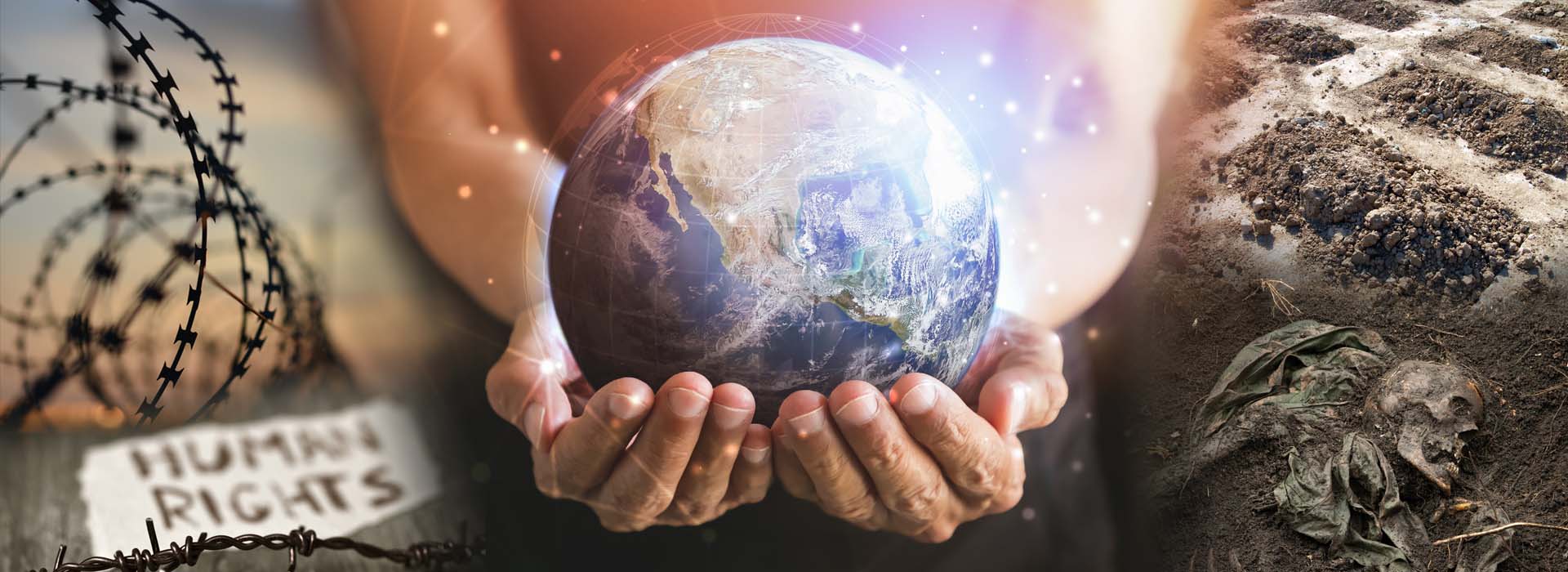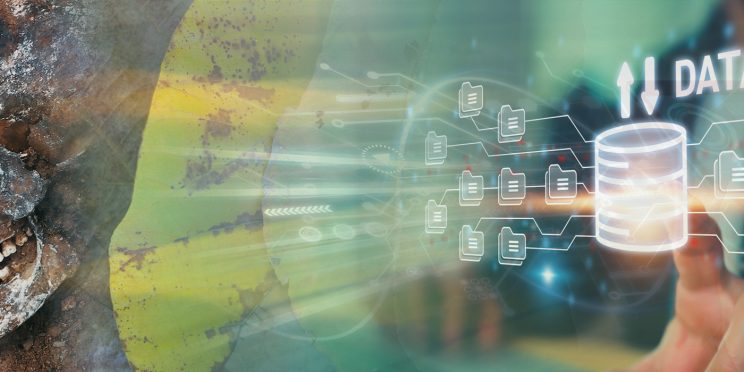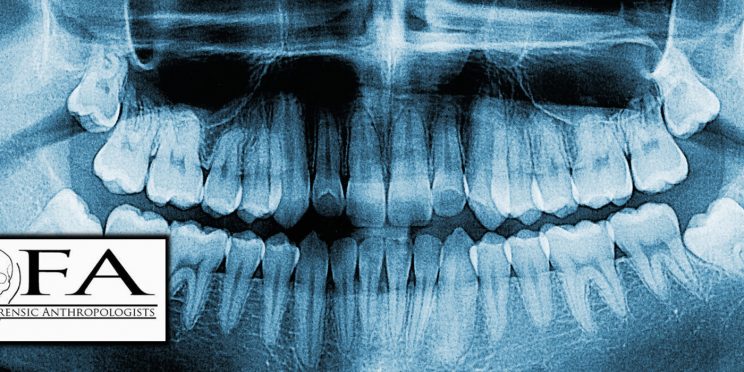← Back to the HHRRC Special Initiative
The Humanitarian and Human Rights Resource Center (HHRRC), an organization within the American Academy of Forensic Sciences (AAFS) supported by the National Institute of Justice's (NIJ's) Forensic Technology Center of Excellence (FTCOE), hosted an in-person poster session where attendees had the opportunity to meet HHRRC researchers and learn about the application of contemporary forensic science and forensic medicine principles to global humanitarian or human rights projects requiring special forensic assistance.
The in-person poster session was hosted at the 75th Annual AAFS Scientific Conference in Orlando, Florida and attendance required conference registration. A selection of digital PDF posters along with short video presentations are accessible below and will remain archived on the website as a virtual library for future viewing purposes.
Poster Session Details
Date
Tuesday, February 14, 2023
6:00pm - 8:00pm ET
Location
Room: Gatlin A-4
75th Annual AAFS Scientific Conference, Rosen Shingle Creek Resort, Orlando, Florida
*Attendance required registration to the conference.
Date
Tuesday, February 14, 2023
Materials became available at 6:00pm ET.
Location
A selection of digital PDF posters along with short video presentations are accessible below and will remain archived on the website as a virtual library for future viewing purposes.
Poster Presentations
Click on the poster title below to jump to that presentation. An asterisk (*) denotes the lead author.
POSTER 1
Accuracies of Artec® Spider®, EinScan® Pro 2X, NextEngine®, and Qlone® (for iPhone®) Photogrammetry for 3D Bone Data Analysis in Forensic Anthropology
Authors: Tom D Beresford*, Carl N. Stephan, Tiina Manne, Kelvin Henderson, & Chris Glen
POSTER 2
African Society for Forensic Medicine
Authors: Uwom Eze*, Robert Ngude, Johansen Oduor, & Gilbert Ngongang
POSTER 3
Capacity Building for Rwandan Medical Officers in the Field of Forensic Pathology Basic Skills
Authors: Herbert Mushumba* & Joseph Kalisa
POSTER 4
Construction of a National Hydrogen and Oxygen Isoscape for Colombia as a Baseline for the Identification of Region of Origin of Unidentified Victims of the Internal Armed Conflict
Authors: Daniela Orozco Ramelli*, Tiffany B. Saul, Ana Carolina Guatame García, Jonathan Drake, & Erica Andrea Castaño Osorio
POSTER 5
Disaster Victim Identification and Migration – The Value of Using Scarification and Tribal Markings as Secondary Identifiers in Mass Fatality Incidents
Authors: Tumisang Thabo Mbedzi*, Stephen Fonseca, & Sally Reynolds
POSTER 6
Fingerprint Scan of the Dead: Real-Time Identification During Search and Recovery Phase in Large Scale Disaster
Authors: Lay See Khoo*, Poh Soon Lai, Muhammad Syafiq Zamasry, Ahmad Hafizam Hasmi, Mohamad Azaini Ibrahim, & Mohd Shah Mahmood
POSTER 7
Insect Succession Patterns During Decomposition in Southern Nigeria
Authors: Izuchukwu S. Etoniru*, Jolandie Myburgh, Maryna Steyn, & Desiré Brits
POSTER 8
Recovery and Analysis of Human Remains Derived from the 1921 Tulsa Race Massacre: Current Findings
Author: Phoebe R. Stubblefield*
POSTER 9
Understanding the Effects of Rehydration on the Rate of Decomposition
Authors: Claire Du Toit*, Jolandie Myburgh, & Desiré Brits
POSTER 1
Accuracies of Artec® Spider®, EinScan® Pro 2X, NextEngine®, and Qlone® (for iPhone®) Photogrammetry for 3D Bone Data Analysis in Forensic Anthropology
Tom D. Beresford*, Carl N. Stephan, Tiina Manne, Kelvin Henderson, & Chris Glen
ABSTRACT
Three-dimensional (3D) scanners are commonly used out of the box without bench tests to establish data acquisition accuracies. This is not ideal for skeletal analysis methods requiring precision in the courtroom. This study reports errors for eight human bones scanned on four 3D capture devices compared with a metrology-grade Solutionix reference scanner.

POSTER 2
African Society for Forensic Medicine
Uwom Eze*, Robert Ngude, Johansen Oduor, & Gilbert Ngongang

ABSTRACT
This project was originally designed to build the capacity of 40 forensic practitioners from Africa divided into four geographic zones. It aimed to train concerned practitioners on human rights within the legal framework in the treatment of detainees across African prisons and detention centers and to provide access to a forensic medical evaluation in line with the Istanbul Protocol when detainees have allegedly been tortured.
POSTER 3
Capacity Building for Rwandan Medical Officers in the Field of Forensic Pathology Basic Skills
Herbert Mushumba* & Joseph Kalisa
ABSTRACT
This project aimed to build capacity for 50 selected non-specialist medical officers working in district hospitals by equipping them with basic forensic pathology skills to determine causes of death, ensure that families know the fates of their loved ones in all death situations, and contribute to vital health statistics in the country.
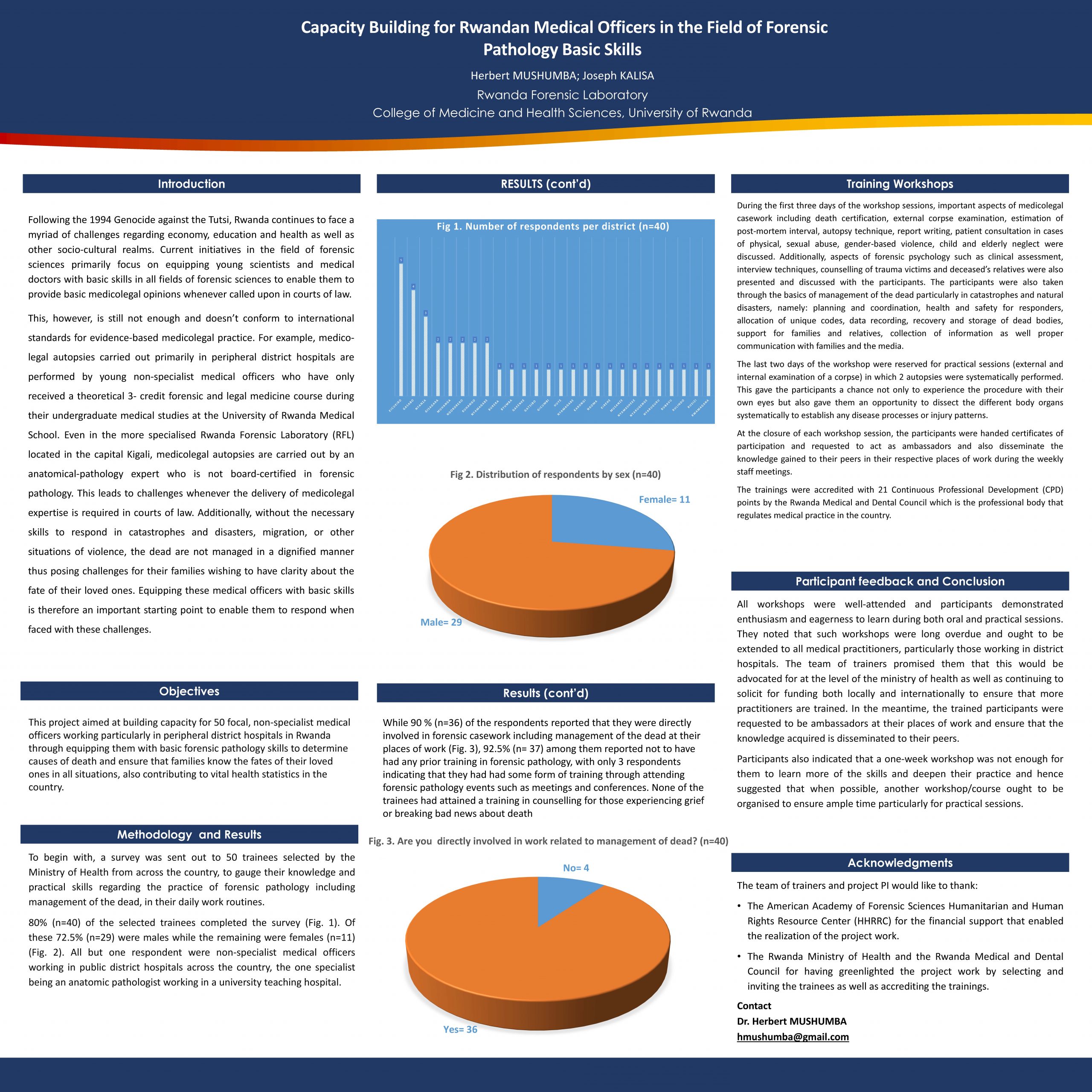
POSTER 4
Construction of a National Hydrogen and Oxygen Isoscape for Colombia as a Baseline for the Identification of Region of Origin of Unidentified Victims of the Internal Armed Conflict
Daniela Orozco Ramelli*, Tiffany B. Saul, Ana Carolina Guatame García, Jonathan Drake, & Erica Andrea Castaño Osorio
Double click to view video full screen.
ABSTRACT
This poster presents the challenges and lessons learned during the construction of a national hydrogen and oxygen isotope reference map for Colombia based on tap water samples (i.e., drinking water). This reference map will guide both the identification of unidentified persons within the country and contribute to global reference databases.
POSTER 5
Disaster Victim Identification and Migration – The Value of Using Scarification and Tribal Markings as Secondary Identifiers in Mass Fatality Incidents
Tumisang Thabo Mbedzi*, Stephen Fonseca, & Sally Reynolds
ABSTRACT
When any mass fatality incident occurs, disaster victim identification must be carried out; all the legal and humanitarian responsibility falls upon the forensic community regardless of the cause. Identification will always be of prime importance in life (ante-mortem) and after death (post-mortem), both for judicial reasons and for providing closure for family members. Scarification and tribal markings have prevailed in Africa. They have immense potential to aid identification in mass disasters and establish the origin of migrants who arrive at mortuaries often labeled as unknown. This research aims to create a comprehensive scarification database and create a digital application that can be used by professionals within forensic institutions.
Double click to view video full screen.
POSTER 6
Fingerprint Scan of the Dead: Real-Time Identification During Search and Recovery Phase in Large Scale Disaster
Lay See Khoo*, Poh Soon Lai, Muhammad Syafiq Zamasry, Ahmad Hafizam Hasmi, Mohamad Azaini Ibrahim, & Mohd Shah Mahmood

ABSTRACT
This study demonstrates the possibility of using a portable biometric reader to capture and match fingerprints for deceased individuals in out-of-mortuary settings. This study demonstrates that rapid victim identification through real-time fingerprint comparison at disaster scenes is a possible means of humanitarian forensic action in the disaster victim identification process.
POSTER 7
Insect Succession Patterns During Decomposition in Southern Nigeria
Izuchukwu S. Etoniru*, Jolandie Myburgh, Maryna Steyn, & Desiré Brits
ABSTRACT
There are no long-term studies on insect succession patterns in Nigeria. This study used 20 domestic pigs to observe decomposition and insect succession patterns in the wet and dry seasons over 14 months. The housefly was the first to arrive—within 5 minutes of depositing the pigs—closely followed by blowflies.
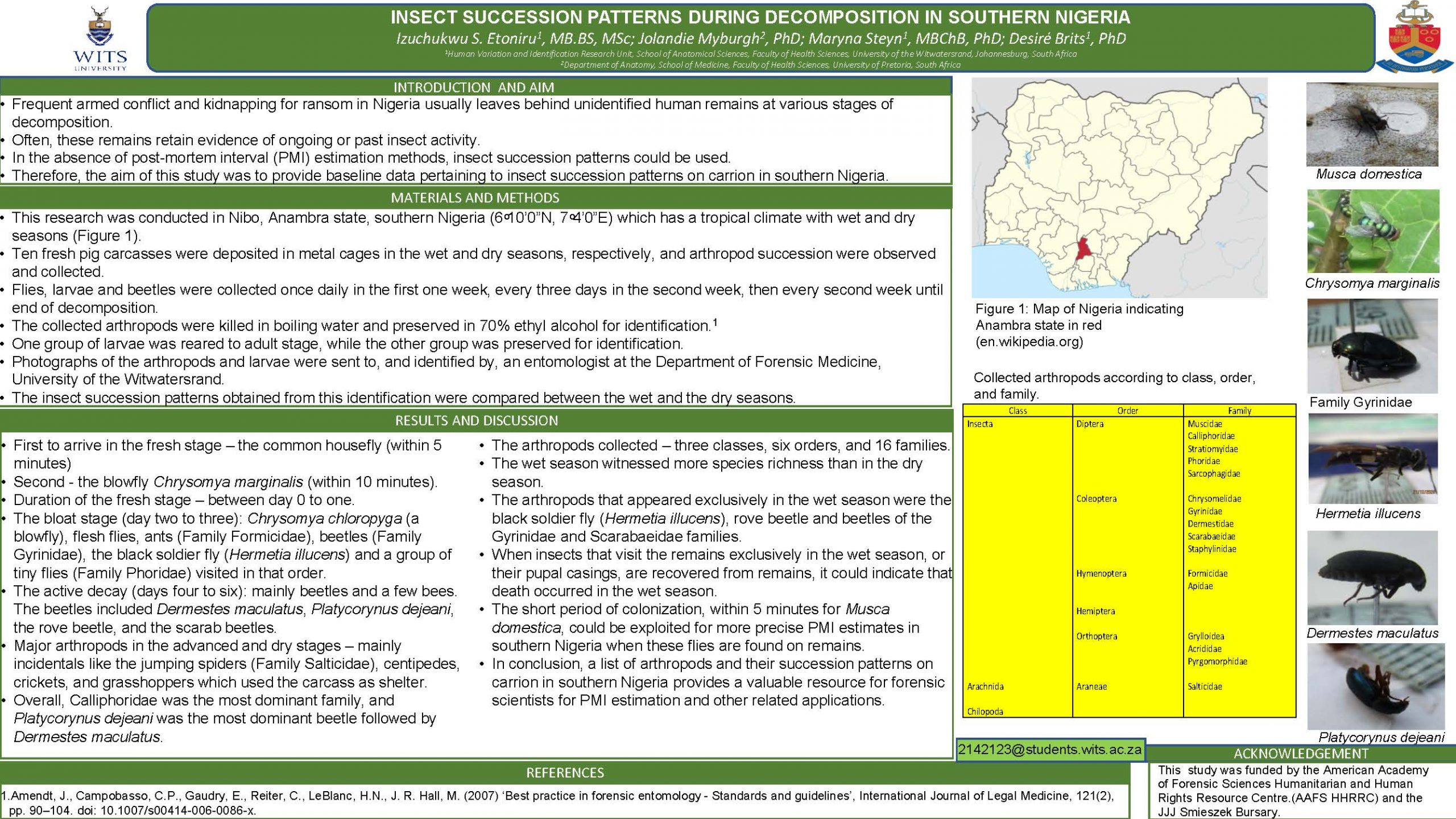
POSTER 8
Recovery and Analysis of Human Remains Derived from the 1921 Tulsa Race Massacre: Current Findings
Phoebe R. Stubblefield*
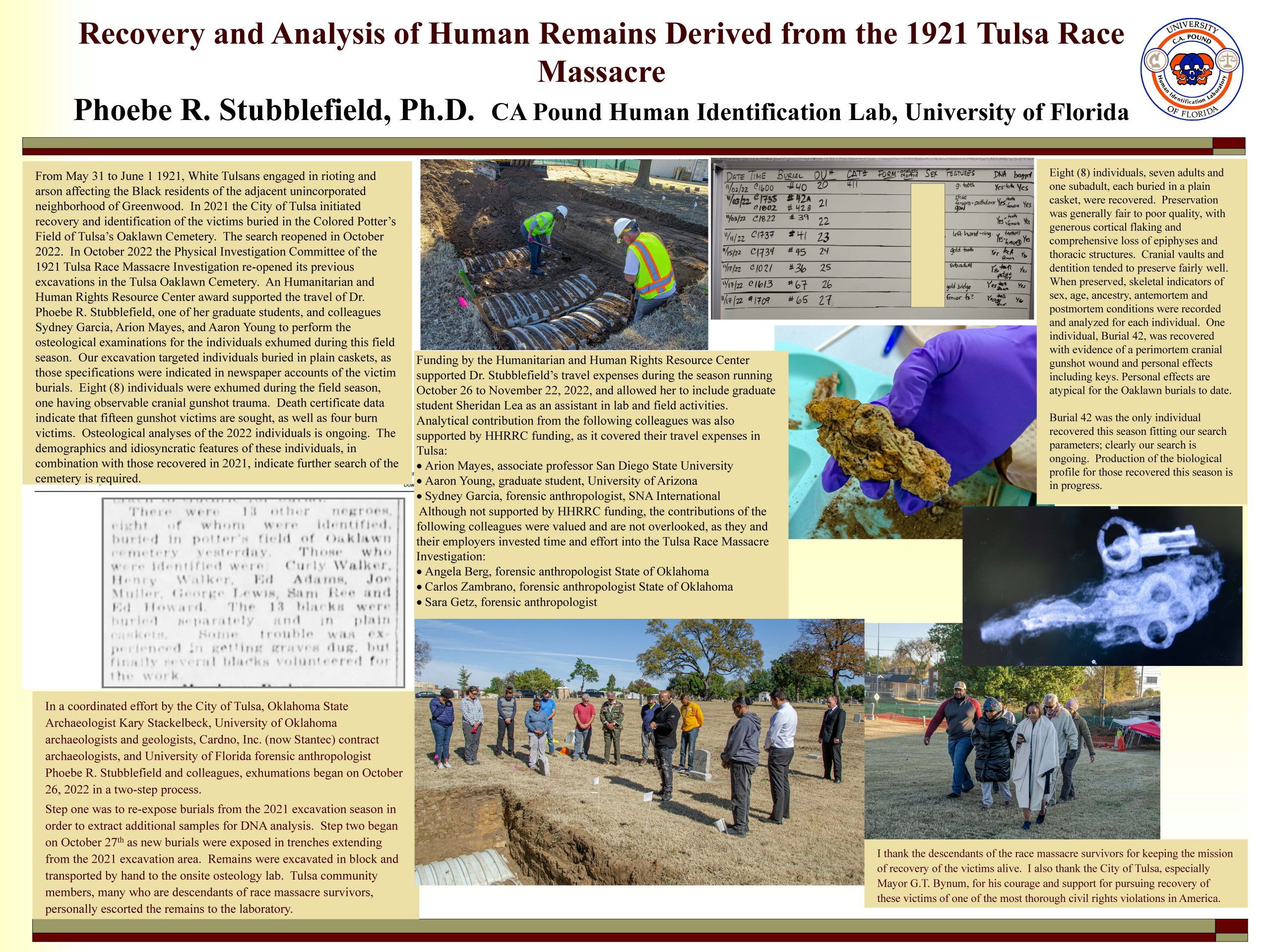
ABSTRACT
In October 2022, the Physical Investigation Committee of the 1921 Tulsa Race Massacre Investigation re-opened its previous excavations in the Tulsa Oaklawn Cemetery. An HHRRC award supported the travel of Dr. Phoebe R. Stubblefield; one of her graduate students; and colleagues Sydney Garcia, Arion Mayes, and Aaron Young to perform the osteological examinations for the individuals exhumed during this field season. The researchers’ excavation targeted individuals buried in plain caskets because those specifications were indicated in newspaper accounts of the victim burials. Eight individuals were exhumed during the field season, one having observable cranial gunshot trauma. Based on information contained in death certificate data, the researchers sought to locate 15 gunshot victims and four burn victims. Osteological analyses of the 2022 individuals are ongoing. The demographics and idiosyncratic features of these individuals, in combination with those recovered in 2021, indicate further search of the cemetery is required.
POSTER 9
Understanding the Effects of Rehydration on the Rate of Decomposition
Claire Du Toit*, Jolandie Myburgh, & Desiré Brits
ABSTRACT
This study assessed the effects of rehydration on the rate of decomposition by artificially rehydrating pig carcasses in advanced stages of decomposition measured by recording the Total Body Score. Post-mortem rehydration of the carcasses showed insect re-colonization, re-initiation, and increase of decomposition whereas the control carcasses stalled once stasis was reached.
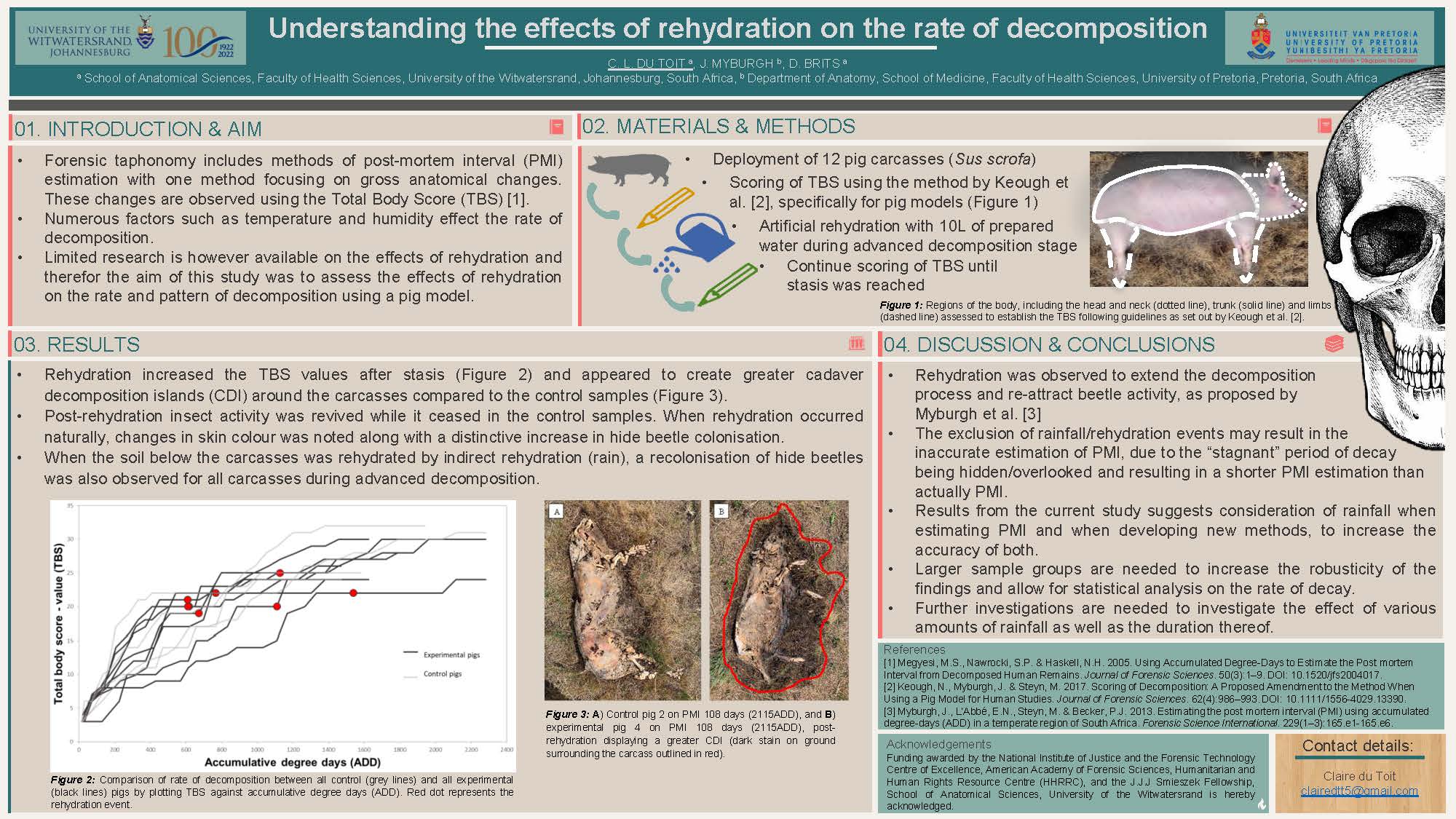
Funding for this Forensic Technology Center of Excellence event was provided by the National Institute of Justice, Office of Justice Programs, U.S. Department of Justice.
The opinions, findings, and conclusions or recommendations expressed in this event are those of the presenter(s) and do not necessarily reflect those of the U.S. Department of Justice.
Contact us at ForensicCOE@rti.org with any questions and subscribe to our newsletter for notifications.

